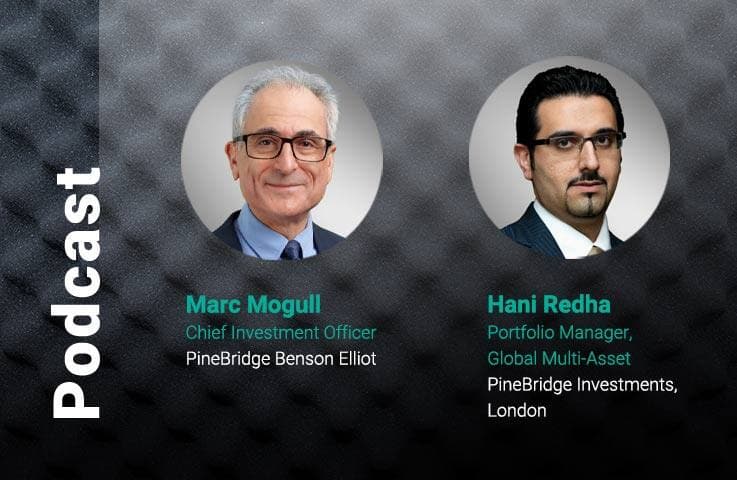Capital Market Line: The Global Growth Gap Widens in Favor of the US

Michael J. Kelly, CFA
Global Head of Multi-Asset

Hani Redha, CAIA
Portfolio Manager, Head of Strategy and Research for Global Multi-Asset

Steven Lin, CFA
Portfolio Manager, Global Multi-Asset

Peter Hu, CFA, FRM
Portfolio Manager, Global Multi-Asset

Sunny Ng, CFA
Portfolio Manager, Global Multi-Asset

Mikhail Johaadien
Research Analyst, Global Multi-Asset

Teresa Wang
Vice President, Research Analyst, Global Multi-Asset

Following a marked slowdown in investment after the global financial crisis, we’ve seen a notable resurgence. What began as a supply response to Covid-related shortages is now morphing into stepped-up innovation-related investments in AI, quantum computing, the energy transition, and reshoring. This revival has driven a rise in productivity that we expect to continue – a trend that has historically defined supply-led growth.
With disinflation at least temporarily stalled, markets are particularly concerned about reflation. While the recent inflation uptick could go on a bit longer, supply-led environments are generally associated with disinflation. Profit margins have also tended to rise when supply-led growth is driven by successful investment in innovation rather than just raw capacity. That’s what we see ahead. Investment-led periods also create an upward pull on real rates. And despite the vicious backup in bond yields in 2024, we don’t see prospects for meaningful declines from today’s levels. Fiscal deficits are ramping nearly everywhere. Unless that changes, the key to containing real and nominal rates will come back to productivity-led disinflation. Trump 2.0 policies are a strange mix of populist reflationary measures (e.g., immigration and tariffs, which are anti-supply-side) and business and productivity-friendly disinflationary policies (incentivizing domestic investment by lowering tax and regulatory hurdles).
The balance of these competing forces will be within Trump’s control. Many argue that Harris/Walz lost the election over inflation and immigration. In the months leading up to November, President Biden reversed his executive orders on immigration. Border crossings quickly plunged back to normal levels, and Trump’s language has already pivoted from “deporting all the illegals” to “deporting the criminals.” His policy advisors throughout have suggested embracing legal, skilled immigration. With border crossings back down, Trump has now pivoted here as well, siding with Elon Musk on the need to boost immigration for highly skilled workers. With these potentially self-inflicted supply shocks fading, all eyes are turning to tariffs. How high and wide will they be? If they can be lessened and stretched out, the pro-business elements of Trump 2.0 will have time to gain the upper hand in his policy mix.
While many (including ourselves) have suggested that the stock market is Trump’s North Star, perhaps its power is that in Trump’s view the stock market foreshadows economic success, and therefore provides the best economic barometer. With today’s thin margins in Congress, Trump needs a favorable midterm election, which will require improved performance throughout 2026 on not only immigration (already in motion) but also on inflation. Susie Wiles, Trump’s incoming chief of staff, has already made the midterms the White House’s top priority. While Trump recently begun referring to himself as “the tariff man,” simultaneously he was sidelining tariff-hungry Robert Lighthizer in favor of business-friendly Howard Lutnick as incoming Commerce Secretary to lead trade policy and renegotiations. High and broad tariffs, implemented in the back half of 2025, will not help the inflation picture throughout 2026, a key period to influence the midterms. This suggests that all options for a trade reset will be pursued, including foreign direct investment (FDI) into the US (dollars, jobs, and intellectual property) and revisiting other trading practices. The more these elements succeed, the less weight tariffs will have in the overall trade reset.
Meanwhile, we do expect imminent tariff announcements that will be as high and as broad as feared. That appears necessary to create urgency among trading partners to renegotiate a trade reset. The key factor to watch will be whether these tariff “announcements” are accompanied by timelines pushing out their implementation well into the second half of 2025. That would allow time for various parties to discuss other ways to reset bilateral trade with the US. If so, the tariff hikes to be announced soon would likely be scaled back to recognize other forms of progress. In the past week, both Trump and Chinese officials have acknowledged that they have already been in contact regarding trade.
Dampened and stretched-out versions of Trump 2.0’s populist immigration and tariff policies, if pursued and successful, would allow the deregulation and energy thrusts to gain a greater share of the policy balance. With the risks of a hard landing now behind us and, in our view, an extension and acceleration of disinflationary supply dynamics likely ahead – versus the market’s opposing worries about overheating once again – we see a continued widening of the global growth gap in favor of the US, especially when considering the stark contrast with the economic landscape in China and the eurozone.
We expect China to keep delaying the finalization of stimulus measures until Trump 2.0’s policies are better known. Only a breakthrough in trade talks that leads to greatly diminished tariff hikes could enable China’s stimulus to potentially counteract the impact of Trump 2.0. Before, during, and even after that, the context remains an ongoing balance sheet recession in China, which, once begun, is tough to end. After the GFC, it took the US and Europe a decade to shake off mild balance sheet recessions. After Japan’s real estate bust, with broken balance sheets in its banking system lingering on, it took three decades to correct. Our baseline expectation is for modest success in negotiations, resulting in narrower tariffs (e.g., 20% on specific goods). Even massive stimulus would then still leave China with the challenge of slowing down its structural slowdown.
In Europe, growth remains sluggish, particularly in Germany, whereas peripheral economies are in somewhat better shape. Businesses that need reasonably priced power continue to migrate out of Germany. Additionally, the significant slowdown in China’s economy is straining Europe’s exporters, once again disproportionately Germany, as well as many emerging markets (EMs) that have become reliant on China. The arrival of Chinese electric vehicles is an approaching challenge, as is the Trump 2.0 trade reset. Some eurozone countries are already beyond their fiscal deficit limits, notably France, while facing the need to boost their defense budgets. Despite numerous challenges, signs of a modest cyclical recovery are emerging in the eurozone, marked by a slight uptick in bank lending. However, it’s not likely to go far until the bloc addresses its competitiveness issues. Mario Draghi put forward one path in his September 2024 report, “The future of European competitiveness.” But knowing and doing are two different things.
Political instability continues to overshadow Europe as well, notably with the recent dissolution of the French government following a no-confidence vote. The widening yield spreads on French sovereign debt reflect market concerns over its persistent fiscal deficits and rising debt. In Germany, the forthcoming elections may lead to a slight relaxation of the country’s stringent “debt brake,” though any fiscal expansion is expected to be limited, with fiscal deficits remaining well below the 3% ceiling that applies to all eurozone members.
A potential peace deal in Ukraine could bolster European growth, yet a comprehensive deal enabling a meaningful rebuilding seems unlikely. Putin, perceiving himself as prevailing in a war of attrition, demands concessions unlikely to be met by the West. We view an extended ceasefire that turns into a frozen conflict (as with North and South Korea) as more likely. This would dampen any rebuilding-related economic bounce.
Overall, with global growth gaps poised to widen further, we continue to favor a modest overweight to US growth assets as well as the US dollar, the latter benefiting from both growing growth differentials and rising interest rate differentials. Within defensive fixed income exposures, we’re building a tilt outside the US that would benefit from less economic vibrancy. Gold has benefitted for some time from global M2 outpacing global nominal GDP. At first, global M2 growth was propelled by quantitative easing by the Western central banks to deal with their balance sheet recessions. Now we see the PBOC taking up this baton by using its balance sheet to fight off China’s balance sheet recession.
While pockets of strength and weakness are shifting, we’re nonetheless upbeat about the coming five years. Any market overreactions to near-term reflation, tariff, or immigration headlines would likely provide opportunities to increase our risk exposures.
Capital Market Line as of 31 December 2024 (Local Currency)

Capital Market Line as of 31 December 2024 (USD View, Unhedged)

Please see Capital Market Line Endnotes. Note that the CML’s shape and positioning were determined based on the larger categories and do not reflect the subset categories of select asset classes, which are shown relative to other asset classes only.
Insights From Today’s CML
Our Capital Market Line (CML) is gradually steepening after a long flat period, though it is not yet steep and continues to exhibit high dispersion. We attribute this to ongoing geopolitical, policy, and technological changes. These factors are currently more powerful than in most historical periods, with their forward-looking impacts on cash flows likely to extend global growth gaps, albeit with high uncertainty. These same forces are elevating opportunities as well as risks, and thus dispersion. We do not rely on long-term mean reversion. Our strategy emphasizes capitalizing on growth driven by longer-lasting technological and geopolitical shifts over the medium term (which we define as five years). Although a global easing cycle is underway, we have been a broken record in pointing out that there are two forms of policy rate-cutting cycles: those that happen during recessions, which are very deep; and those that occur without hard landings, which are more modest. We have not been in the camp that real or nominal interest rates would revert to post-financial-crisis norms during this policy rate-cutting cycle, or in its aftermath. That was an aberrant, stagnant period. Ahead we expect an era of change that spurs investment, which should continue providing an upward pull on real rates. Growth assets like equities are particularly well positioned to gain from this more vibrant and dynamic period ahead.
Equities tend to outperform in global easing cycles, and more so in modest easing cycles. Current policy rate cuts are slowly fortifying both high-end consumers (through wealth effects) and lower-income groups and small businesses (through lower floating-rate debt). Larger companies that access capital markets have witnessed a lower cost of equity juxtaposed with a higher cost of medium- and long-term debt, despite the policy rate cuts at the short end. In the US, forthcoming pro-business initiatives aim to nurture a supply-driven economy despite interim hurdles from tariffs and immigration policies in 2025, and we expect ongoing efforts to mitigate the immediate reflationary aspects of Trump 2.0. The goal is to incentivize investment to continue boosting productivity, thereby shifting supply curves ahead of demand curves. We see significant potential for more US companies and industries to benefit from this trend. While rising investments in US equities are difficult for some to justify based on their concerns regarding historical norm-based valuations, sectors like large US banks and US mid-caps offer comparable valuations to overseas equity markets while enjoying improving fundamentals – especially when compared to international peers. Outside the US we find the most promising opportunities in India and Taiwan equities, which align with our focus on structural growth areas (like productivity and new energy). Areas that benefit from structural changes are particularly important in periods of stepped-up change.
Credit spreads are tight, but opportunities exist. In the current “Balanced Growth” regime, the typical correlation between stocks and risk-free bonds is now hovering around zero, compared to roughly -0.4 during the “Stall Speed” regime. At any given level of the rates curve, this lessens the appeal of risk-free fixed income relative to growth assets. Also, credit spreads remain tight across most markets, supported by the strong growth environment. That said, there are a few pockets of opportunity that stick out, particularly Asia’s high yield bond market (excluding China’s property sector) and to a lesser extent US mortgage-backed securities (MBS), where spreads are typical in an otherwise tight market. Additionally, the potential for banks to retain deposits could increase with further rate cuts, which might ease some of the technical constraints on MBS.
Underweight duration. In the aftermath of the Fed initiating its policy rate-cutting cycle, yields at the medium to longer end of the US Treasury curve rose. They did again after the US election, and once again after the Fed adopted a more hawkish stance on disinflation stalling out by reducing its rate-cut guidance for 2025. Despite interest rates hovering higher than in most of the post-financial-crisis period, that period reflected the unusual conditions inherent to balance sheet recessions and was an aberration of tepid consumption and investment. Post-Covid we have witnessed a rise in investment appetite that we think will continue. Along with 2022’s Covid-related inflation came a supply response in the form of investment. This inflation, related policy tightening, and renewed appetite for investment all caused a massive selloff in the Treasury market. Despite this, we find US duration today merely at fair value after a decade of extreme overvaluation. We see it as relatively uninspiring compared to risk assets in a much more robust growth environment, as well as its diminished potential to diversify risk assets, since it no longer has a predictable negative correlation to such asset classes. Hence, we have been leaning away from duration in the US. Where there is now a growing case to become more neutral to US duration, Bunds appear more enticing than US Treasuries given the deep and intransigent troubles in Germany.
Gold is viewed as a reliable geopolitical risk diversifier. We view gold as a reliable geopolitical risk diversifier amid deteriorating international economic relations. While a prolonged ceasefire in the Russia-Ukraine conflict might temporarily dampen gold prices, a comprehensive peace agreement – potentially requiring a significant reduction of sanctions on Russia – appears less likely than an extended ceasefire without a formal deal. Meanwhile, the ongoing trend toward de-dollarization among Global South central banks is expected to continue, supporting gold prices. Since the GFC, gold has enjoyed a long-tenured bull market as Western central banks’ quantitative easing policies led global M2 money supply growth to significantly outpace global GDP growth. Today, even as the Fed and the ECB are shrinking their balance sheets, the PBOC is moving quickly in the opposite direction in a manner that more than offsets Western shrinkage. Should the PBOC continue to swell its balance sheet to combat its creeping balance sheet recession, which would be rational given its policy requirements, China’s M2 growth alone would reboot the expansion of global M2 relative to global nominal GDP. This would likely add a new leg to gold’s ascent.
The Fundamentals Driving Our CML
Transitioning to a Balanced Policy regime. Following the GFC, Western economies grappled with mild balance sheet recessions characterized by sluggish consumption and investment as the private sector deleveraged. The clash between diminished investment and a strong inclination to save, which would typically drive rates down, was intensified by monetary policies such as quantitative easing (QE) and negative interest rates in certain nations. Interestingly, fiscal policy was fairly passive during this period of private sector deleveraging, forcing policy adjustments disproportionately on monetary authorities. This era, which PineBridge’s Multi-Asset team now refers to as the “old abnormal,” persisted throughout the deleveraging period, yet ended around 2015. During this period, our CML cash flow growth projections reflected less growth. While we attempted to reflect more lenient capitalization rates as well, here we did not adequately account for the magnitude of monetary excess. Capitalization rates became even more lenient than we expected.
Since then, we have been morphing to faster growth supported by healthier household and corporate balance sheets as well as a period of secular change. Post-Covid, fiscal policy has veered from a fairly passive to a very activist stance. We have been boosting our cash flow growth projections more often than not in our quarterly updates, yet reflecting growing divergences. We continued that in this period, yet also began reflecting a growing divide in geographic equity and credit risk premiums – and among sectors as well, some of which have cash flows that appear better suited for a period of accelerating structural change.
AI as a catalyst for productivity. Technological advancements and improved human capital investments are reshaping labor, business models, and national security landscapes. Tools like generative AI are set to automate a significant portion of tasks across numerous jobs, enhancing labor efficiency, creating new job opportunities, and boosting overall productivity. This transformation not only increases US labor productivity but also drives innovation and efficiency across various sectors, positioning AI as a key driver of future economic growth and supply-led expansion.
Geopolitical shifts are affecting supply growth. Rising geopolitical tensions are prompting Western companies to diversify their supply chains away from China toward politically aligned or geographically closer regions like the US, Mexico, India, and Vietnam. Emerging markets still offer cost advantages, even if they’re far less than when globalization began; nonetheless, the overall expenses of relocating supply chains could exceed those of operating in China. In a world moving toward deglobalization, securing supply chains becomes costlier, driving medium-term inflation pressures and stimulating investment. Those trends are being driven by strategic and geopolitical considerations, becoming another driver for investing in increased productivity.
The energy transition drives growth while reducing savings. The ongoing energy crisis, sparked by the conflict between Russia and Ukraine, has accelerated the shift toward green energy. Initiatives like the US Inflation Reduction Act and the EU’s Green Deal Industrial Plan reflect this push, promoting investments in low-carbon energy technologies. This increase in decarbonization and defense expenditures is expected to stimulate economic growth and maintain tight markets in certain sectors (metals and real interest rates, to name a couple). Yet it is likely to reduce the global savings glut.
ESG 2.0. We’re seeing a noticeable shift in ESG practices, particularly outside the eurozone, toward what is being termed “ESG 2.0.” Instead of focusing on exclusionary investing to cut off certain industries and companies from capital, ESG 2.0 focuses on actively engaging with companies to enhance their ESG standards rather than just divesting or excluding them from consideration. To date, those with improving ESG scores are witnessing improvements in their cost of debt. So ESG 2.0 incentivizes industries with traditionally poor ESG metrics to improve by targeting their capital costs. High-emission industries leveraging significant cash flows for greener transitions have often praised the ESG 2.0 approach for its hands-on engagement by stakeholders. This proactive strategy is vital in closing the $2.9 trillion funding gap needed to make meaningful progress on emissions. It bears watching which approach proves more effective.
Capital Market Line Endnotes
The Capital Market Line (CML) is based on PineBridge Investments’ estimates of forward-looking five-year returns and standard deviation. It is not intended to represent the return prospects of any PineBridge products, only the attractiveness of asset class indexes, compared across the capital markets. The CML quantifies several key fundamental judgments made by the Global Multi-Asset Team for each asset class, which, when combined with current pricing, results in our annualized return forecasts for each class over the next five years. The expected return for each asset class, together with our view of the risk for each asset class as defined by volatility, forms our CML. Certain statements contained herein may constitute “projections,” “forecasts,” and other “forward-looking statements” which do not reflect actual results and are based primarily upon applying a set of assumptions to certain financial information. Any opinions, projections, forecasts, and forward-looking statements presented herein are valid only as of the date of this document and are subject to change. There can be no assurance that the expected returns will be achieved over any particular time horizon. Any views represent the opinion of the investment manager and are subject to change. For illustrative purposes only. We are not soliciting or recommending any action based on this material.
About the Capital Market Line
The Capital Market Line (CML) is a tool developed and maintained by the Global Multi-Asset Team. It has served as the team’s key decision support tool in the management of our multi-asset products. In recent years, it has also been introduced to provide a common language for discussion across asset classes as part of our Investment Strategy Insights meeting. It is not intended to represent the return prospects of any PineBridge products, only the attractiveness of asset class indexes compared across the capital markets.
The CML quantifies several key fundamental judgments made by the Global Multi-Asset Team after dialogue with the specialists across the asset classes. We believe that top-down judgments regarding the fundamentals will be the largest determinants of returns over time driving the CML construction. While top-down judgments are the responsibility of the Multi-Asset Team, these judgments are influenced by the interactions and debates with our bottom-up asset class specialists, thus benefiting from PineBridge’s multi-asset class, multi-geographic platform. The models themselves are intentionally simple to focus attention and facilitate a transparent and inclusive debate on the key drivers for each asset class. These discussions result in 19 interviews focused on determining five year forecasts for over 100 fundamental metrics. When modelled and combined with current pricing, this results in our annualized expected return forecast for each asset class over the next five years. The expected return for each asset class, together with our view of forward-looking risk for each asset class as defined by volatility, forms our CML.
The slope of the CML indicates the risk/return profile of the capital markets based on how the five-year view is currently priced. In most instances, the CML slopes upward and to the right, indicating a positive expected relationship between return and risk. However, our CML has, at times, become inverted (as it did in 2007), sloping downward from the upper left to the lower right, indicating risk-seeking capital markets that were not adequately compensating investors for risk. We believe that the asset classes that lie near the line are close to fair value. Asset classes well above the line are deemed attractive (over an intermediate-term perspective) and those well below the line are deemed unattractive.
We have been utilizing this approach for over a decade and have learned that, if our judgments are reasonably accurate, asset classes will converge most of the way toward fair value in much sooner than five years. Usually, most of this convergence happens over one to three years. This matches up well with our preferred intermediate-term perspective in making multi-asset decisions.
Disclosure
Investing involves risk, including possible loss of principal. The information presented herein is for illustrative purposes only and should not be considered reflective of any particular security, strategy, or investment product. It represents a general assessment of the markets at a specific time and is not a guarantee of future performance results or market movement. This material does not constitute investment, financial, legal, tax, or other advice; investment research or a product of any research department; an offer to sell, or the solicitation of an offer to purchase any security or interest in a fund; or a recommendation for any investment product or strategy. PineBridge Investments is not soliciting or recommending any action based on information in this document. Any opinions, projections, or forward-looking statements expressed herein are solely those of the author, may differ from the views or opinions expressed by other areas of PineBridge Investments, and are only for general informational purposes as of the date indicated. Views may be based on third-party data that has not been independently verified. PineBridge Investments does not approve of or endorse any republication of this material. You are solely responsible for deciding whether any investment product or strategy is appropriate for you based upon your investment goals, financial situation and tolerance for risk.



